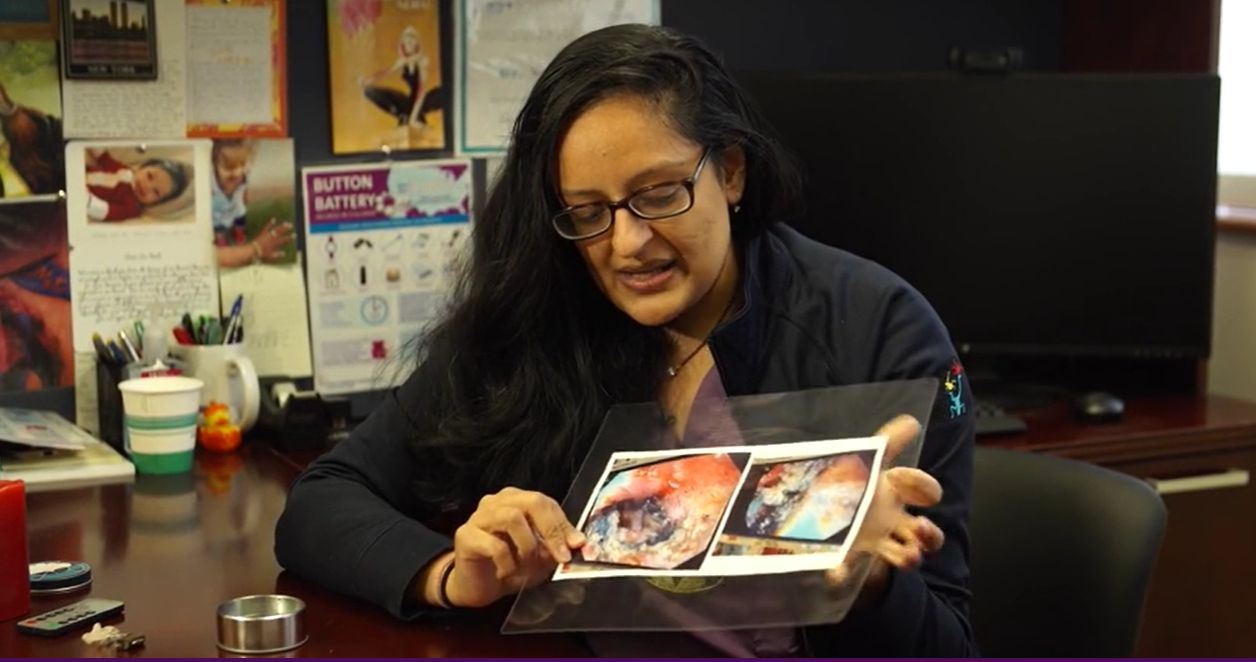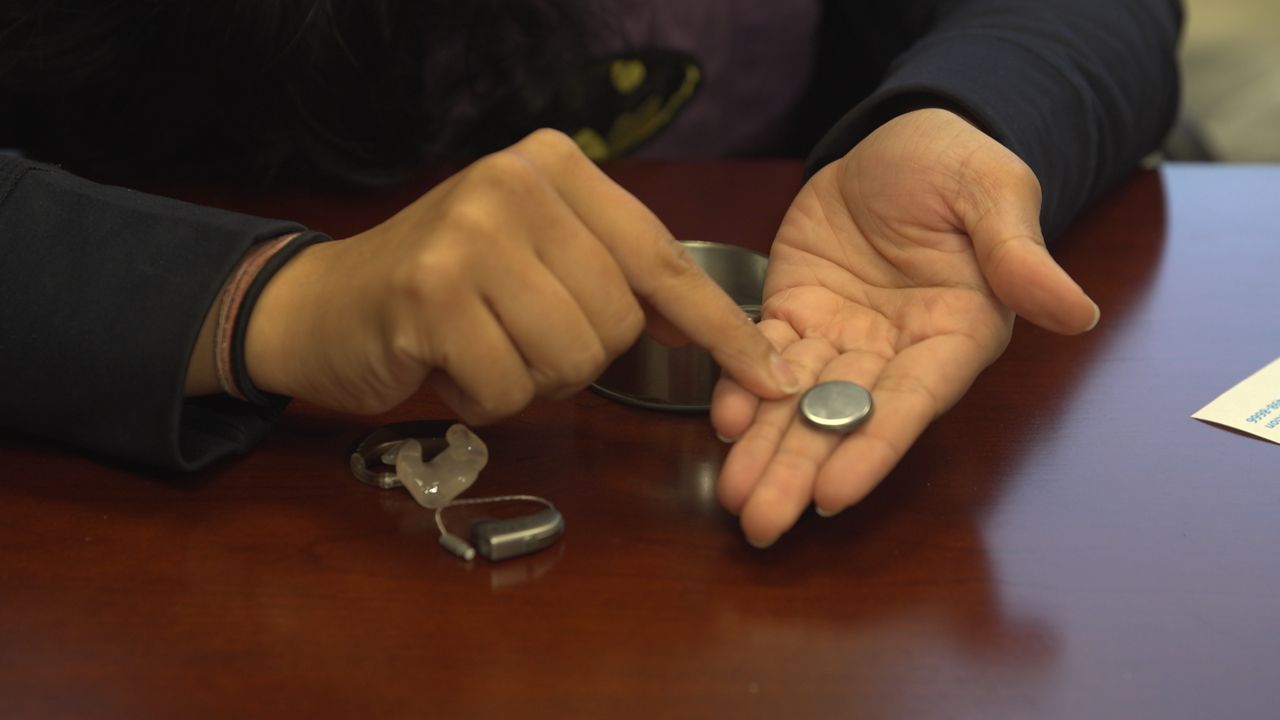If you or a loved one has swallowed a coin-shaped cell battery, call Poison Control or the National Battery Ingestion Hotline at 1-800-498-8666.
It is easy to overlook the batteries needed for certain toys or devices when we’re gift shopping during the holidays. But health experts are urging the public to pay close attention to items like electronic candles, thermometers, small lights, toys, hearing aides and remote controls — anything that requires coin-shaped cell batteries, known as lithium button batteries.
Experts are reminding consumers to make sure the product is manufactured in a way that keeps those batteries tightly secured.
The batteries are smooth, shiny and cool to the touch; exactly the sort of thing a baby or toddler — maybe even a five-year old — would find tempting to explore and place in their mouth or nose.
What few people know is that these batteries aren’t just something a child will swallow and pass during a bowel movement the next day. The impact of ingesting these batteries could be much, much greater.
We spoke with Northwell Health Pediatric Otolaryngologist Dr. Neha Patel, more commonly referred to as an ear, nose and throat doctor. Patel said they’ve noticed a rise in battery ingestions.
“Last year we saw six in a two-month period. Normally, we see six in a 12-month period. So these are becoming more readily available. And they are definitely seeing more visits in the emergency room because of this,” said Patel.
The National Battery Ingestion Hotline shows a steady rise in batteries swallowed between 2002 and 2016.
The vast majority of kids survive accidental ingestion of batteries, mainly due to the quick action of their families and hospital personnel. But if a chemical reaction is triggered inside the body after a battery is swallowed or lodged in a nose or ear, severe damage can occur.
“The battery itself can conduct electricity, and the chemicals released can actually cause a life- threatening, electrochemical reaction in the body,” said Patel. “It's like a bomb went off in the throat. Sometimes this takes just minutes. Other times, two hours. But if it doesn't get out quickly, it can cause lasting, permanent damage or even death.”

Patel said when a child is brought into an emergency department due to accidental ingestion of a battery, it triggers an all hands on deck response.
“We set off a series of events, so the emergency room is aware, the pediatric otolaryngology team is aware, the pediatric gastroenterology team, the ICU team, the anesthesiology team, the pediatric surgery team.”
After the battery is removed, the treatment continues. “They still need long term follow-up because some of them will have permanent swallowing issues. They could have vocal fold weakness. They could have issues with their airway,” said Patel.
In response to a growing number of accidental battery ingestions, some manufacturers have added a bitter taste to the batteries so children are more likely to spit them out.
This past summer, Congress passed Reese’s Law — named after an 18-month old girl who died after ingesting a battery. The law requires the Consumer Product Safety Commission to create standards that require warning labels and child-resistant closures on products using the batteries.
The first step if a loved one has swallowed a battery is to call Poison Control or the National Battery Ingestion Hotline at 1-800-498-8666.
Below is a lightly edited Q&A with Dr. Patel on things you should keep in mind if someone you know swallows a button battery, or if you suspect they’ve swallowed it.
Billups: “What is happening in the throat when a battery is lodged there that causes that small explosion?”
Dr. Patel: “There are hydroxyl radicals that are released and this causes a necrosis or tissue death. So it actually kills the mucosa of the esophagus and it can erode through the structures in that area, including the aorta, which is a big blood vessel and that can lead to life threatening bleeding. It can also lead to long term scarring. Even weeks after the batteries are removed, you can see some long-term damage from it. You can have scarring of the esophagus to the point that it's hard for children to swallow. And this can cause long-term dysfunction even that can really seriously affect their quality of life.”
Billups: “If a battery is swallowed, what should the first step be for parents? Should they try and get the child to pass it?”
Dr. Patel: “You never want to wait for them to pass it. This damage can be done within 15 minutes. Serious damage we've seen within two hours of swallowing it. So the minute you think a child has swallowed a battery, you want to come to the emergency room right away, especially a lithium battery like this can cause severe, severe damage. So we tell them not to eat or drink anything and go to the emergency room right away. If they actually witnessed [them ingest] this foreign body and a child is older than one and the battery has been in for less than 12 hours, you can give a tablespoon of honey* on your way to the emergency room, but you shouldn't delay going to the emergency room to find honey. The honey might neutralize some of the damage, but besides that, really just go to the emergency room right away.”
Billups: “Why honey?”
Dr. Patel: “Coating this battery with honey can potentially prevent some further damage. But you want to be careful for kids less than one with honey because of the botulinum toxin. If the battery has been in for over 12 hours, it can already cause permanent damage to the esophagus. Even the hole in the esophagus, we call it a perforation and if there's honey through there, then it can cause worsening symptoms, infection.”
*Poison control experts suggest giving two tablespoons of honey every 10 minutes while making your way to the ER.
Billups: “What do you do if you don't know whether your child swallowed a battery?”
Dr. Patel: “Sometimes, you're not going to witness a child swallowing and choking on a battery. Sometimes they're playing, they find it on the floor, and then you might see them kind of touching their throat, maybe a little bit of discomfort, maybe not wanting to eat. Some kids might not know how to communicate, ‘Hey, something feels off. There's something stuck in my throat.’ Some signs to look out for are noisy breathing, drooling, difficulty swallowing, not wanting to eat. So if your child suddenly has a new onset of these symptoms, that's a good reason to bring them to the emergency room.”
Billups: “What's the first step when you get to the hospital?”
Dr. Patel: “When a child comes in with these symptoms, we do an x-ray right away. Thankfully, that button batteries are easily identified on an x-ray. So when the emergency room sees a patient with a button battery, it's going to light up and there's going to be two rings. It's called a double halo, and that's a sign that it's a button battery. So if anyone in the emergency room sees a double halo or on this view a step off that's actually corresponding to the button battery, that's an emergency that initiates a rapid protocol where we take the child to the operating room right away.”
Billups: “What does the surgery entail to get the battery out?
Dr. Patel: “We go in with a special camera if the gastroenterology team is doing it. Because the battery's lower, they'll go in with a flexible camera. If we're (ear, nose and throat doctors) doing it, it is because the battery is up high. We'll go in with something called a rigid esophagus scope and it goes in through the mouth and then we put special optical forceps so we can actually see as we're taking it out. The instruments that we use to take it out have a little camera at the end of it, and we can find the battery and grasp it and take it out at the same time. If there is significant damage, very rarely we would have to do an open surgical approach to it. But thankfully with these new instruments, we are not doing that often.”
Billups: “What else needs to be done beyond the legislation, coating batteries with a bitter film?
Dr. Patel: “I would definitely want school professionals to know about this. They take care of kids all day, and the more they know, the more they can look out for signs in school. Pretty much all of us have exposure to kids in our lives, whether you're a grandparent that has a child that's coming over, if you're a aunt or uncle.”
Billups: “On a slightly different, but related note, we have these really strong magnets in my house that we use to post pictures and cards on our door. We’ve made a point to educate our kids about the dangers of these magnets. Do you see a lot of children ingesting those?
Dr. Patel: “We see it, we see it. Especially if you swallow multiple magnets, that is a recipe for disaster. So the magnets themselves, if let's say if one magnet gets caught at one end of the swallowing tube and one magnet is in the intestines, they can actually attach to each other and then cause a perforation through those. The magnet effect is more intensified if there are multiple magnets or a magnet and a metal object in there. Most button batteries, anything in the esophagus, that is a surgical emergency. But if it's if there's something lower down that's ready to pass like a metal dime or something like that, that they might watch and wait for it to pass. But anything that's a battery, we would consider that our emergency.”



